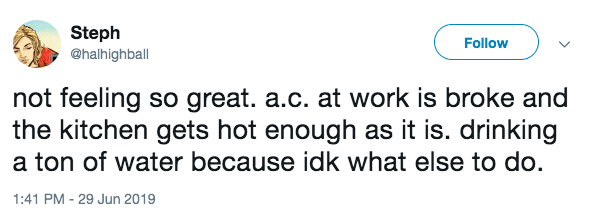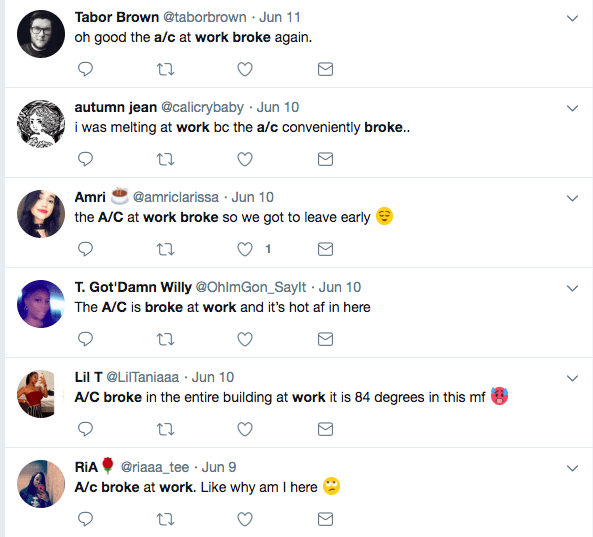What to do if your boss won’t fix the air conditioning
JULY 8, 2019 | COWORKER.ORG
Lots of folks love the warm summer weather, but it can be less enjoyable — and even dangerous — for workers when temperatures increase in their workplaces. For example, what happens if the air conditioning breaks in your workplace on a hot, summer day?

Every year, stories come out during the summer months about employees working through incredible heat. Some recent examples from June 2019:
- A health inspector issued a citation to a Subway location in Houston when the temperature of the food preparation area reached “around 89 degrees after AC malfunction, leading employees ‘to sweat excessively.’”
- Five employees were taken away in ambulances from New Orleans’ Sewerage and Water Board Headquarters when the air conditioning broke.
And if you take a look through social media, you’ll find all kinds of similar examples:

We really mean it… There’s a lot if you start looking…
So what can you do if your workplace is overheating?
As we’ve noted in a post about whether you can be fired for missing work during extreme weather, there are few legal protections in the U.S. for workers in this case, too.
Can OSHA help? There are currently no OSHA (Occupational Safety and Health Administration) regulations on a national level for temperature on the workplace. One avenue for protection: “The General Duty Clause section 5(a)(1) of the Occupational Safety and Health Act stipulates that a business has the obligation to provide a workplace that ‘is free from recognizable hazards that are causing or likely to cause death or serious harm to employees.’… the issue has to be extreme.” So, a hot day at work might not necessarily meet this standard, but if you think the heat is reaching this dangerous level, you can file a complaint with OSHA here. OSHA also has some information related to frequently asked questions about indoor air quality on its website here.
What about your state? While there might not be clear federal protections, some states are taking action — for the most part by offering some basic help to outdoor workers. Recent reporting by FairWarning notes: “three states — California, Washington and Minnesota, along with the military — have created their own heat protections for workers. In California, for instance, employers must provide water and shade to workers when temperatures reach 80 degrees or higher. Workers also must be given rest breaks every two hours when the thermometer hits 95 degrees or above.” California’s Division of Occupational Safety and Health (Cal/OSHA) is currently in the process of finalizing new standards related to indoor workplace temperature and heat index.
Get together with your coworkers: Workers have power when they work together and there might be collective strategies you can take to improve your situation. Section 7 of The National Labor Relations Act protects the right of many non-supervisory employees to work together to improve their terms and conditions of employment. This protection includes the right of employees to speak publicly to improve your and your coworker’s working conditions, wages, benefits, and other aspects of their employment. It also protects the rights of workers to organize in many other ways including actions like: starting a petition with your coworkers, working with your coworkers to ask your employer for a microwave in the break room, removing forced arbitration for all employees, speaking to press about those issues, and other actions you believe will improve your workplace. (For more information on these topics, check out our FAQs).
There have been quite a few examples in recent years of coworkers taking collective action together when the air conditioning broke down in their workplaces. Workers at a New York City McDonald’s walked out after a coworker reportedly collapsed while working without air conditioning and a McDonald’s employee from Georgia who joined a similar protest said one of his coworkers had “passed out twice from the heat.” Workers at Popeyes locations in Philadelphia and Austin have staged walkouts to protest high temperatures in their restaurants.
You can also start your own campaign on Coworker.org. Thousands of workers have successfully taken action using Coworker.org: Starbucks baristas won paid parental leave; Uber added an in-app tipping feature after drivers spoke out; and REI increased wages and updated scheduling policies for retail workers.
Looking for other tips? Check out this post for some do’s and don’ts for engaging colleagues and supporters on a workplace issue or this simple guide to talking about workplace issues with your coworkers.
Coworker.org is a global platform to advance change in the workplace. Our technology makes it easy for individuals or groups of employees to launch, join and win campaigns to improve their jobs and workplaces. You can start your own campaign about changes you want to see in your workplace on Coworker.org here — or contact us at [email protected] if you would like to discuss a workplace issue with our team.
LABOR WORKERS RIGHTS STRIKE


